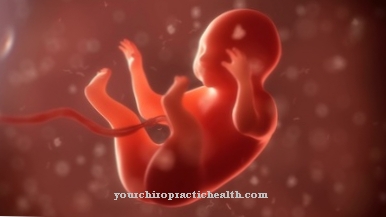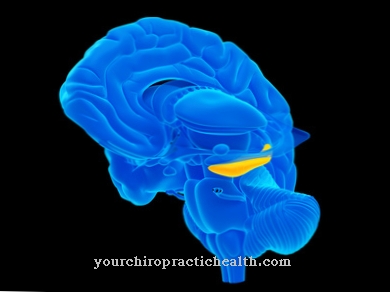The Ulnar abduction is a spreading of the fingers or hand towards the ulna and thus the opposite of the radial abduction towards the ulna. Radial and ulnar abduction take place in the proximal wrist and are performed by various muscles of the hand. Ulnar abduction pain is present, for example, in lesions of the ulnar disc.
What is ulnar abduction?

Joints are movable bone connections. They give the human limbs their wide range of motion. Joints are capable of different types of movement to varying degrees, depending on their location. Four of the most important types of movement are flexion, extension, abduction and adduction.
The extension corresponds to an active or passive stretching movement. Flexion is the opposite of this type of movement. It describes the active or passive flexion of limbs in a particular joint. Adduction occurs when a part of the body is brought up to the side of the body or the respective limb. It takes place on the frontal level and usually leads to the longitudinal axis of extremities. On the other hand, an extremity moves away from the longitudinal axis during abduction. The abduction corresponds to the lateral spreading or leading away of an extremity from the center of the body. Abduction and adduction mainly affect the joints of the fingers and hand.
In this context, ulnar abduction is understood as an abduction of the hand or finger in the direction of the ulna, which is also called ulna in medical parlance. In contrast, the abduction towards the spoke is called radial abduction.
Function & task
The ulnar abduction is performed in the wrist. In medicine, this means the proximal and distal joint of the wrist. The proximal carpal joint corresponds to an articulated connection between the distal radius and the proximal carpal bone. The triangular bones, scaphoid bones and the lunar bones make up these carpal bones. Together with an inter-joint disc from the distal radial-ulnar joint, these bones form the proximal carpal joint. The joint capsule of the area is stabilized by ligaments.
The proximal carpal joint is functionally an egg joint with two degrees of motion. In addition to flexion, it is capable of extension. In connection with the flexion, the palmar flexion of the hand or finger towards the palm of the hand should be mentioned, which can take place in up to 80 degrees. In connection with the extension, however, the dorsiflexion of the hand and fingers towards the back of the hand should be emphasized, which is up to 70 degrees.
The proximal wrist performs the radial abduction towards the spoke and the ulnar abduction towards the ulnar. The spreading towards the spoke takes place with up to 20 degrees. The ulnar abduction is around 40 degrees.
The distal carpal joint is made up of the individual joints of two adjacent bones. Because of its curved shape and strong ligaments, the distal carpal joint is significantly more static and inflexible than the proximal one. It is therefore restricted in its mobility, but forms a functional unit together with the proximal carpal joint. The spreading movements of the hand and fingers come to the proximal joint in the distribution of work in this unit.
The ulnar abduction in the joint is carried out by the three muscles, extensor carpi ulnaris, flexor carpi ulnaris and extensor digiti minimi muscles. These muscles correspond to the ulnar hand flexor, the elbow-side hand extensor and the little finger extensor.
You can find your medication here
➔ Medicines for muscle painIllnesses & ailments
If pain occurs during ulnar abduction, there can be several causes for this phenomenon. One of the most common causes is a lesion of the ulnar disc. This anatomical structure lies between the proximal carpal row and the ulna. In young people, lesions of this structure are usually due to overloads that have caused a crack in the structure. In older people, on the other hand, there may be degenerative symptoms in the ulnar disc, which cause the structure to fray.
Those affected by such a lesion usually experience more or less severe pain. With ulnar abduction of the hand or fingers, the pain reaches a climax. Occasionally the pain symptoms are accompanied by a cracking or swelling.
The diagnosis of a lesion in the ulnar disc is made by MRI. If the cause is degenerative, treatment is carried out with anti-inflammatory drugs. The wrist is immobilized and cooled. In younger people, the tear may be sewn together. Arthroscopic removal of the ulnar disc is also conceivable.
Pain during ulnar abduction of the fingers or hand can also be due to muscular disorders of the three muscles involved. Such diseases can be, for example, inflammation of the tendon sheath. Osteoarthritis of the proximal wrist may also be a possible cause. At the beginning of the illness, osteoarthritis pain is load-dependent, but later spreads to the rest phases. In the course of the process, the wrist can no longer be fully used, so that ulnar abduction, for example, can only be performed to a limited extent or not at all.
However, the inability to perform ulnar abduction can just as easily be attributed to paralysis of the muscles involved. Such paralysis is conceivable in the context of peripheral and central nervous disorders and is usually associated with more or less severe sensitivity disorders in the affected area. In the case of central nervous or peripheral nerve diseases, a diagnosis using imaging methods is required, for example an MRI of the head and spine and imaging of the affected hand.













.jpg)

.jpg)
.jpg)











.jpg)